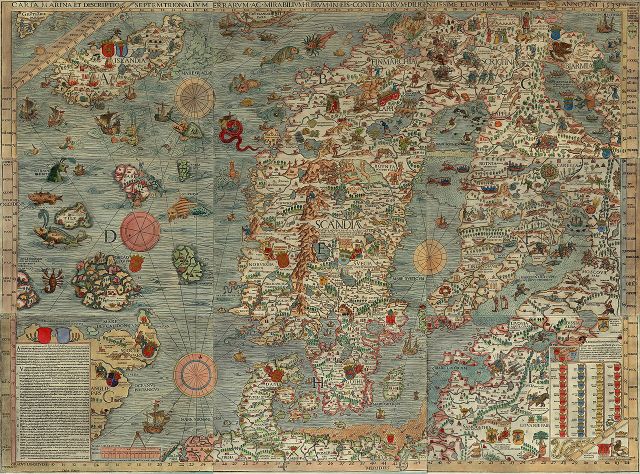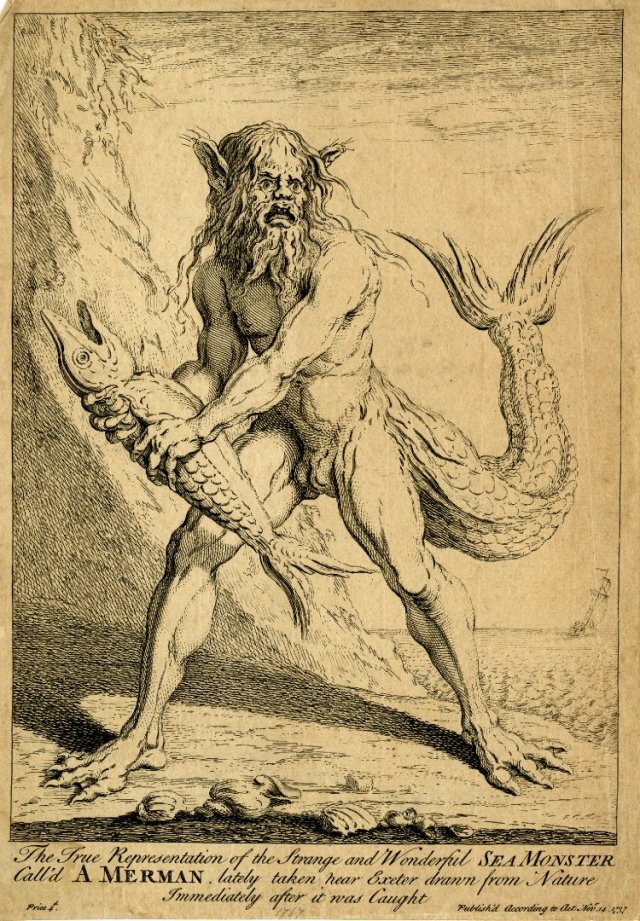There have always been rumours of mermaids and mermen in the seas, and these appear to have been seen on a fairly regular basis during the eighteenth-century with the newspapers so helpfully providing us with detailed descriptions of such creatures. We will leave our readers to judge for themselves whether any of these accounts could have even a grain of truth.

Weekly Journal or Saturday’s Post, Saturday, August 31, 1717
Letters from Leghorn of the 15th tell us that there has been seen in those seas a terrible mermaid or rather merman; that it shows itself at least 13 or 14-foot-high above the water; but if any boat or vessel makes towards it, then it makes a strange frightful noise and plunges into the sea. Several that have been it represent it as the most hideous monster that has ever been seen in the world.
Dublin Journal, Tuesday, October 12, 1725
Some particular advices from Brest, in France say that on that coast has lately appeared a strange sort of sea monster, in the form of a man, eight-foot-high call’d a merman; his teeth are white as ivory, he hath black curl’d hair, flat nose and in other members proportionable to his stature without deformity.

Weekly Journal or British Gazetteer (London, England), Saturday, December 11, 1725 provides a somewhat lengthy and detailed description of the merman, sadly there seems to be no evidence of any of the people named actually existing – unless you know otherwise, if so, we would love to hear from you.
The wind being easterly, we had thirty fathoms of water, when at ten o’clock in the morning a sea-monster like a man appeared near our ship; first on the larboard where the mate was, whose name is William Lomone, who took a grappling iron to pull him up: but our captain named Oliver Morin, hindered him, being afraid that the monster would drag him away into the sea. They said Lomone struck him only on the back to make him turnabout, that he might view him the better. The monster being struck, showed his face, having his two hands closed, as if he had expressed some anger. Afterwards he went round the ship. When he was at the stern he took hold of the helm with both hands and we were obliged to make it last, lest he should damage it. From thence he proceeded to the starboard, swimming still as men do. When he came to the forepart of the ship he viewed for some time the figure that was in our prow, which represented a beautiful woman; and then he rose out of the water, as if he had been willing to catch that figure. All this happened in sight of the whole crew. Afterwards he came again to the larboard, where they presented to him a codfish banging down with a rope. He handled it without spoiling it and then remove the length of cable and came again to the stern where he took hold of the helm a second time.
At that very moment, Captain Morin got a harping iron ready and took it himself to strike him with it, but the cordage being entangled he missed his aim and the harping iron touched only the monster, who turned about sowing his face as he had done before. Afterwards he came again to the fore part and viewed again the figure. The mate called for the harping iron but he was frightened fancying that this monster was one La Commune, who had killed himself in the ship the year before and had been thrown into the sea in the same passage. He was contented to push his back against the harping iron and the monster showed his face as he had done at other times.
Afterwards he came along the board so that one might have given him the hand. He had the boldness to take a rope held up by John Mazier and John Dessiere who being willing to pluck it out of his hands, drew him to our board and rising out of the water to the navel we observed that his breast was as large as that of a woman of the best plight. He turned upon his back and appeared to be a male. Afterwards he swam again round the ship and then went away; we have never seen him since.
I believe that from 10 o’clock till 12 that this monster was along our board, if the crew had not been frightened he might have been taken many times with the hand being only two feet distant.
The monster is about eight-foot-long: his skin is brown and tawny without any scales. All his motions are like those of men; the eyes of a proportionate size, a little mouth, a large and flat nose, very white teeth, black hair, the chin covered with a mossy beard, a sort of whiskers under the nose, the ears like those of men, fins between the fingers and toes of his hands and feet, like those of ducks. Which is certified to be true by Captain Oliver Morin, John Martin, pilot and the whole crew consisting of two and thirty men.

© The Trustees of the British Museum
Common Sense or The Englishman’s Journal, Saturday, July 29, 1738 (we’re loving the title of the publication in light of the subject matter!). It provides us with a completely different description of a merman.
4 feet and a half in length, having a body much resembling that of a man, with a genital member of considerable size; together with jointed legs and feet extending from his belly 12 or 13 inches, with fins at this thighs and larger ones, like wings in the form of which those angels are often painted, at his shoulders, with a broad head of very uncommon form, a mouth 6 inches wide, smellers, or kind of whiskers at his nostrils, and two spout holes behind his eyes through which he ejected water when take 30 or 40 feet high.
And for our final offering we have, from the Universal Spectator and Weekly Journal), Saturday, May 5, 1739 the following:
They write from Vigo in Spain that some fishermen took on that coast a sort of monster, or merman, 5 feet and a half from its foot to its head, which is like that of a goat. It has a long beard and mustachoes, a back skin somewhat hairy; a very long neck, short arms and hands longer and bigger than they ought to be in proportion to the rest of the body; long fingers, like those of a man with nail like claws; very long toes join’d like the feet of a duck and the heels furnish’d with fins resembling the winged feet with which the painters represent Mercury. It has also a fin at the lower end of its back, which is 12 inches long and 15 or 16 broad.

fascinating! thank you!
LikeLike
Delighted you enjoyed it 🙂
LikeLiked by 1 person
Why do I wonder if the parts they haunted were used by smugglers with a vested interest in scaring people off?
LikeLike
That seems highly likely doesn’t it, or are we just cynical lol:)
LikeLike
Or maybe it’s just Heyer overload and the thought of Richmond playing ghost in The Unknown Ajax …
LikeLiked by 1 person
Pingback: Whewell’s Gazette: Year 2, Vol. #49 | Whewell's Ghost
Reblogged this on Lenora's Culture Center and Foray into History.
LikeLike
Pingback: Legends of the sea | Lenora's Culture Center and Foray into History